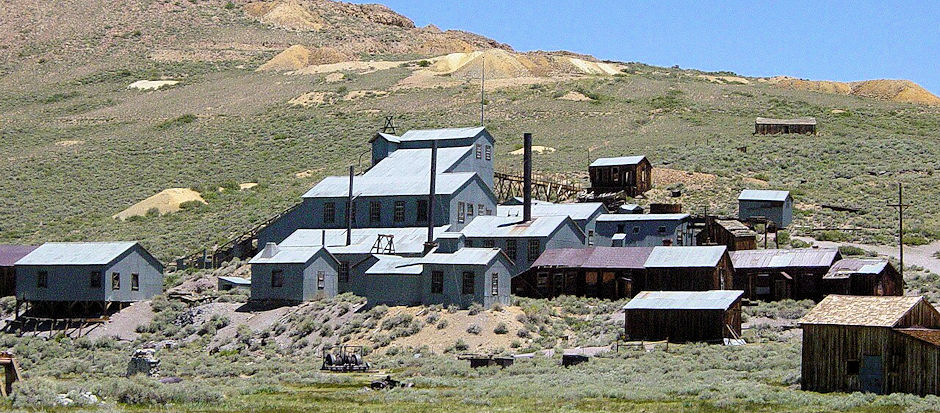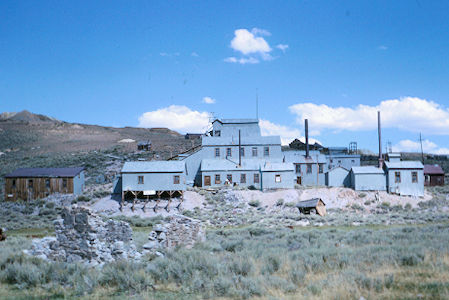Aerial view of the Standard Stamp Mill facility
The mine was known as the Bunker Hill Mine when it was registered in July 1861. It passed through several hands before being sold for $67,000 to four partners who changed the name and incorporated as the Standard Consolidated Mining Company in April 1877. Read about History regarding Discovery of the Standard Mine.
The Standard Mine yielded nearly $15 million over 25 years, and its success caused the 1878 rush to Bodie. Within a year, the population rose from about 20 to an estimated 10,000 miners, gamblers and other entrepreneurs.
The mill was destroyed by fire in 1898, but was rebuilt the following year. Between 1860 and 1941, the Bodie Mining District produced close to $100 million in gold and silver. During those years, gold prices ranged from $20 to $35 an ounce; the price of silver ranged from 70 cents to $1 an ounce. The mill last operated in 1938. The Standard was the most successful of the 30 different mining companies that operated in the Bodie Mining District.
Text from the Bodie State Historic Park tour book
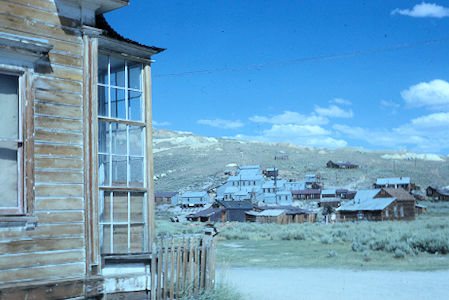
Joseph Stuart Cain house and Standard Stamp Mill - August 25, 1962
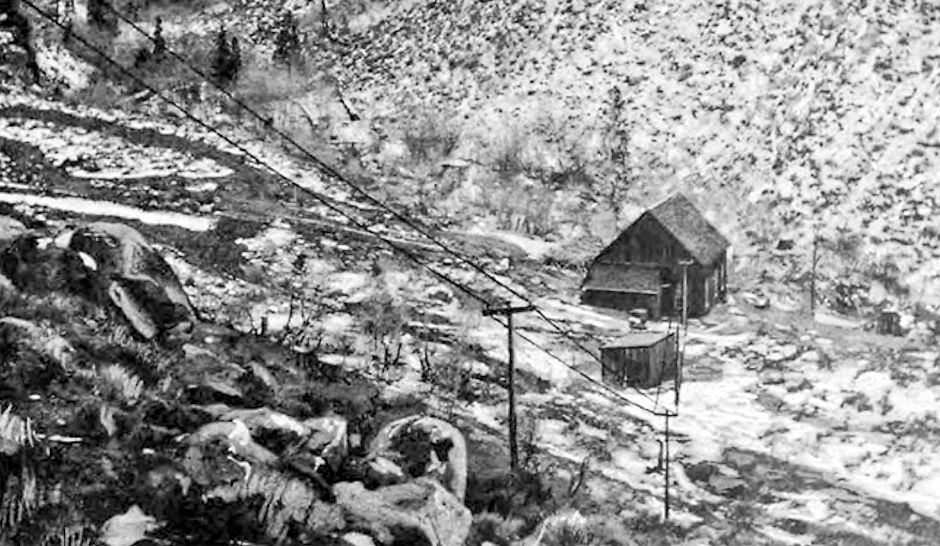
The Green Creek Power Plant, source of electric power for the Standard Mill in Bodie, as shown in an 1894 article by Thomas Leggett.
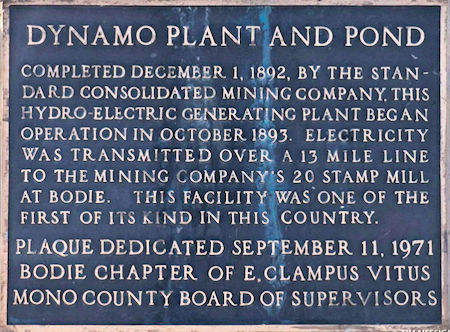
Plaque at Green Creek Power Plant
Originally, the Standard Consolidated Mill was run by steam power, but wood was a resource that was expensive and became more expensive as it had to be hauled from further and further away. In November 1892, Thomas H. Leggett convinced James Cain to invest in his idea of transmitting power over a long distance. The power was to be used to in the Mill, which would greatly reduce the amount of wood needed, and thus the costs associated with it.
Cain agreed and work began. The Mill had new electrical equipment installed, a power substation was built, and lines were run from the Mill to the substation, and from the substation to Green Creek, where the Hydroelectric Power Plant was built.
In fact, the lines were run 13 miles in a straight line! At the time, it’s believed that engineers weren’t sure if the power would ‘jump out of the line and into the ground’ on sharp corners – on the other hand, it’s costs less to run a straight line, rather than adding footage for turning corners…
Read about Developments in Electricity and Bodie’s Long Distance Transmission Line and details about the Electrical Line from the Green Creek Power Plant to Bodie. Includes maps of the "straight line" power line.
Here is some information about the processes used in the mill. The purpose of the Standard Stamp Mill was Getting Gold and Silver Out of Rocks - Milling Ore at Bodie.
Here on Beyond Nevada Expeditions are an excellent collection of pictures. Scroll down for pictures related to the Standard Stamp Mill.
 View looking east at the Standard Stamp Mill and the ancilliary buildings associated with the millng process
View looking east at the Standard Stamp Mill and the ancilliary buildings associated with the millng processPhoto by Jet Lowe 2000 - Library of Congress
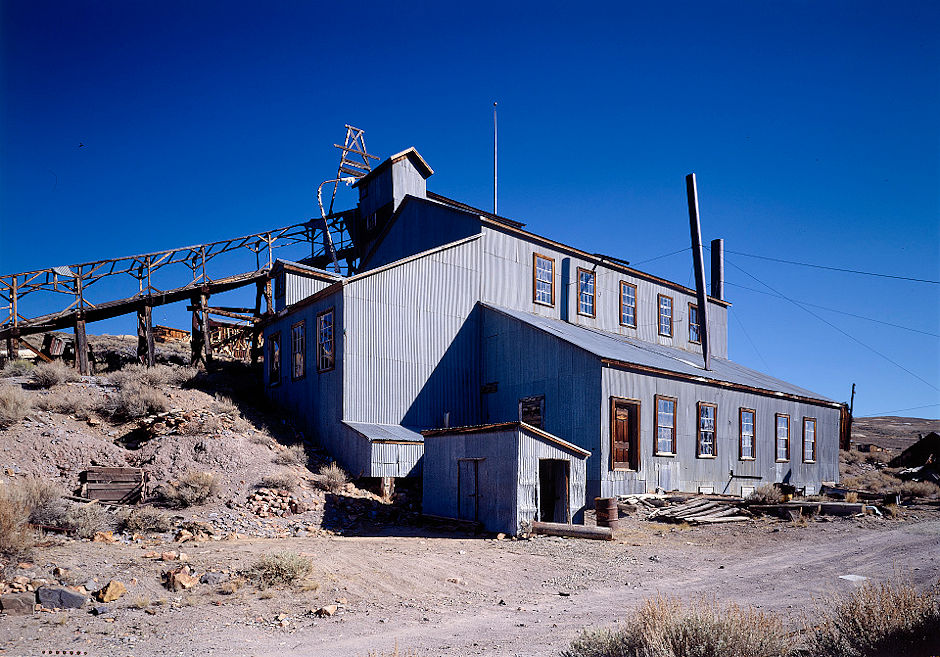 Oblique view of the southwest corner of the mill building - Photo by Jet Lowe 2000 - Library of Congress
Oblique view of the southwest corner of the mill building - Photo by Jet Lowe 2000 - Library of Congress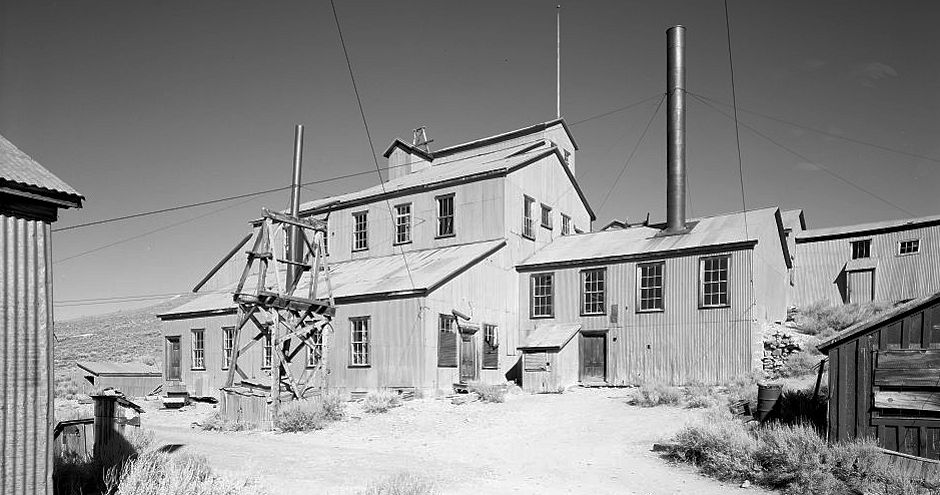
. Oblique view of the mill looking northeast. The Vanner Room is the forward most section of the building. A wood frame over the well is visible in the foreground left. The boiler room is the addition to the main building in the center right. The machine shop and annex are visible behind the boailer room - Photo by Jet Lowe 2000 - Library of Congress
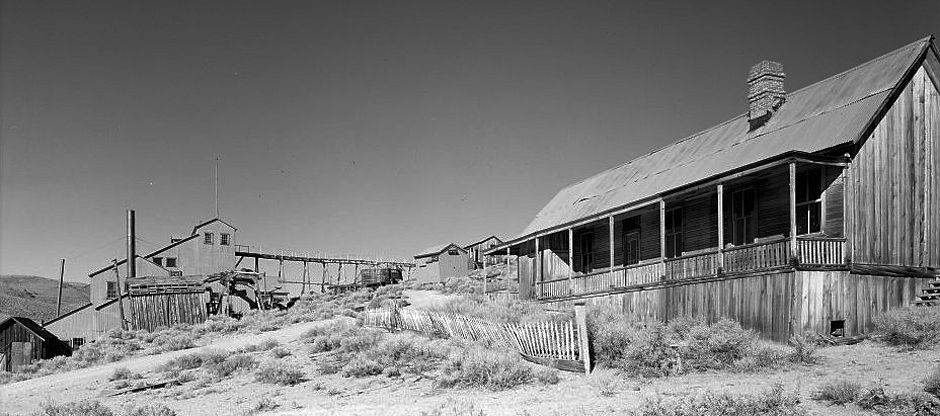
View looking north-northeast showing the mill in the background left. In the foreground right is the former Superintendent's House. the house is referred to as the Hoover house by the Park Staff because Theodore Hoover, Herbert Hover's brother was the Superinetndent of the mill and lived there during the 1905 era - Photo by Jet Lowe 2000 - Library of Congress
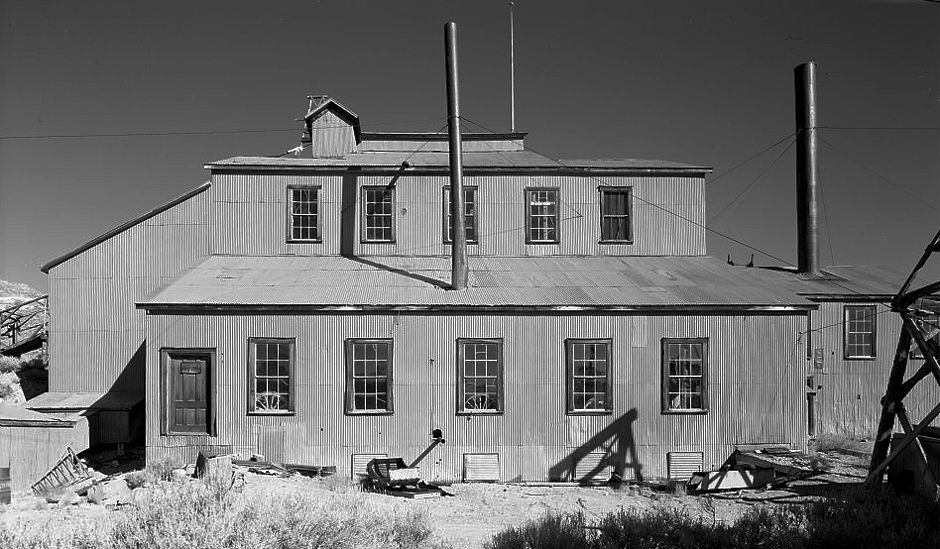
View looking east at the west elevation of the mill. The lower set of windows provide light for the Vanner Room. The upper set of windows provides light into the levels that contain the main power shaft. The grizzly ore separators and the jaw crasher for oversized ore - Photo by Jet Lowe 2000
Library of Congress
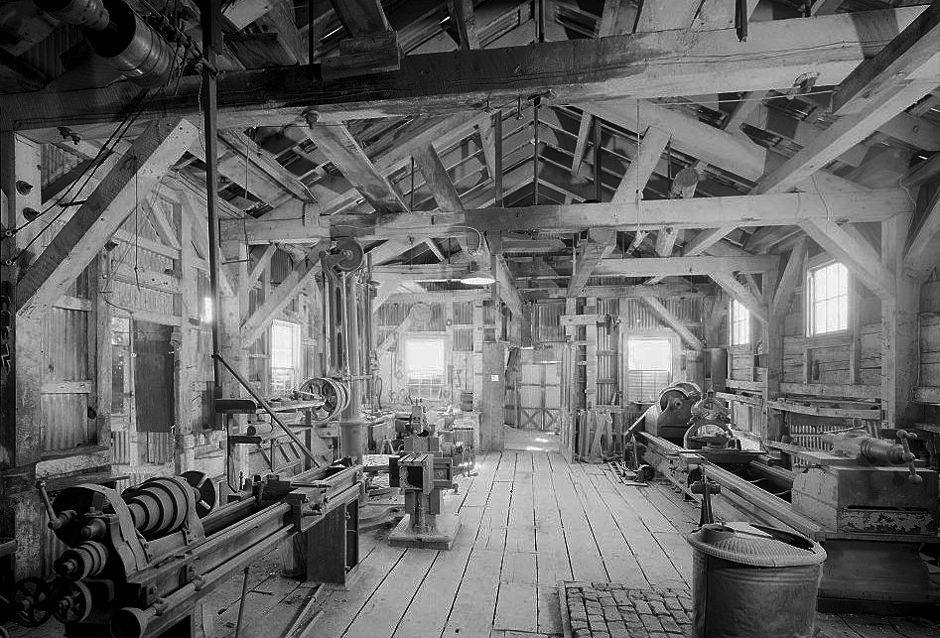
Interior view of the machine shop looking south. From left to right, pulley's above for the lathe below, entrance to the electrical motor room, boring machine, planer, tool, bench against the back wall, doorway into the annex, long lathe, wood stove in the foreground right - Photo by Jet Lowe 2000 - Library of Congress
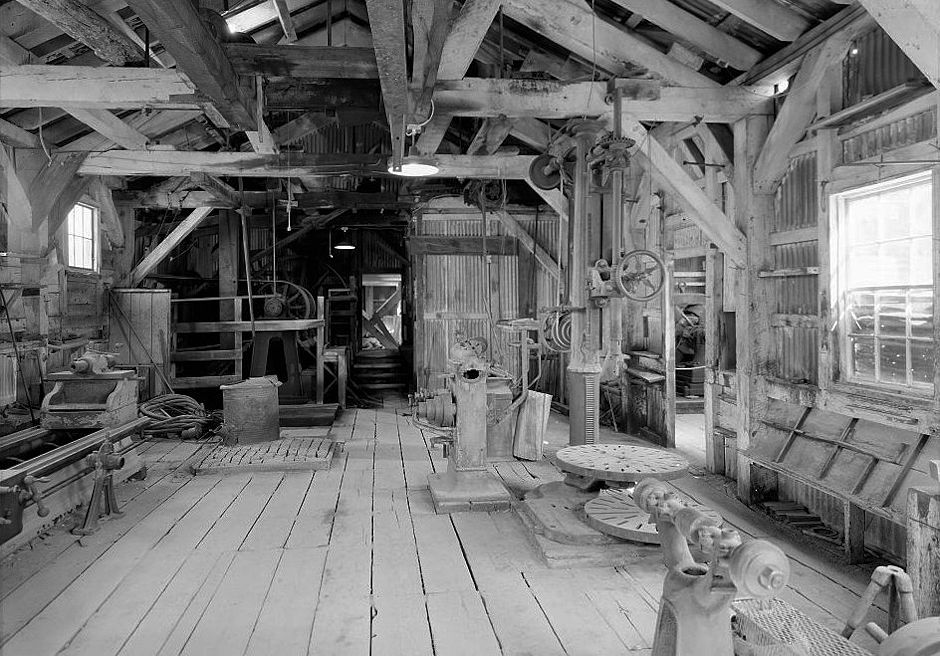
Interior view of the machine shop looking north. From left to right, north end of the long lathe, wood stove with a brick hearth floor, far back left corner is the main clutch for the mill power shafts, shaft lathe, small planer, boring machine with ionic column detail, and the entrance to the electrical moror room - Photo by Jet lowe 2000 - Library of Congress
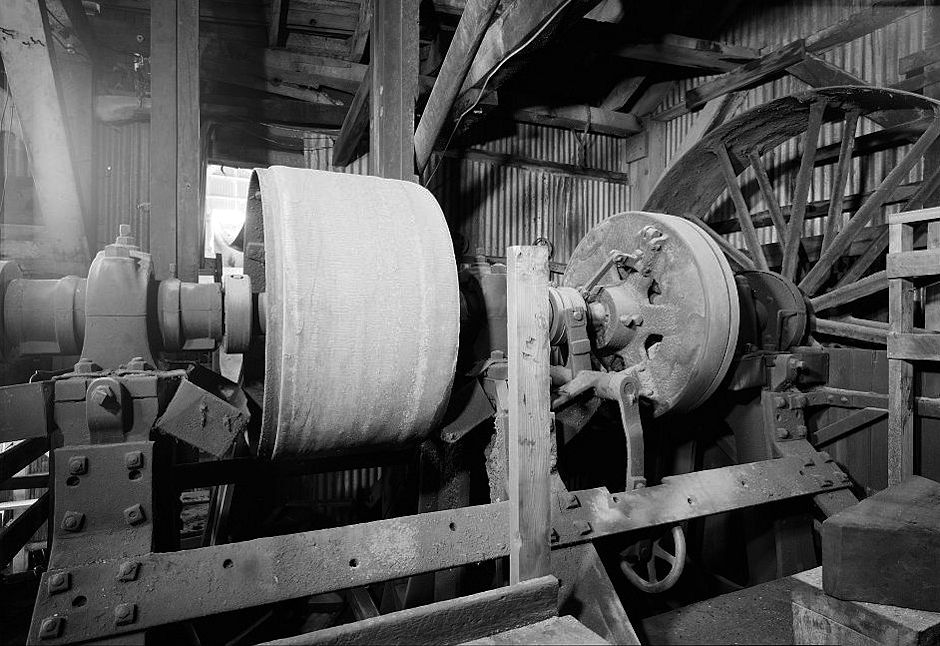
Detail view of the clutch mechanism for the mill power distribution system from left to ritht. Transfer wheel with a balt that connects to the drive wheel of the main power shaft. The clutch mechanism, the drive wheel that received its power from a belt connected to transfer wheel in the electric motor room (behind camera) - Photo by Jet Lowe 2000 - Library of Congress
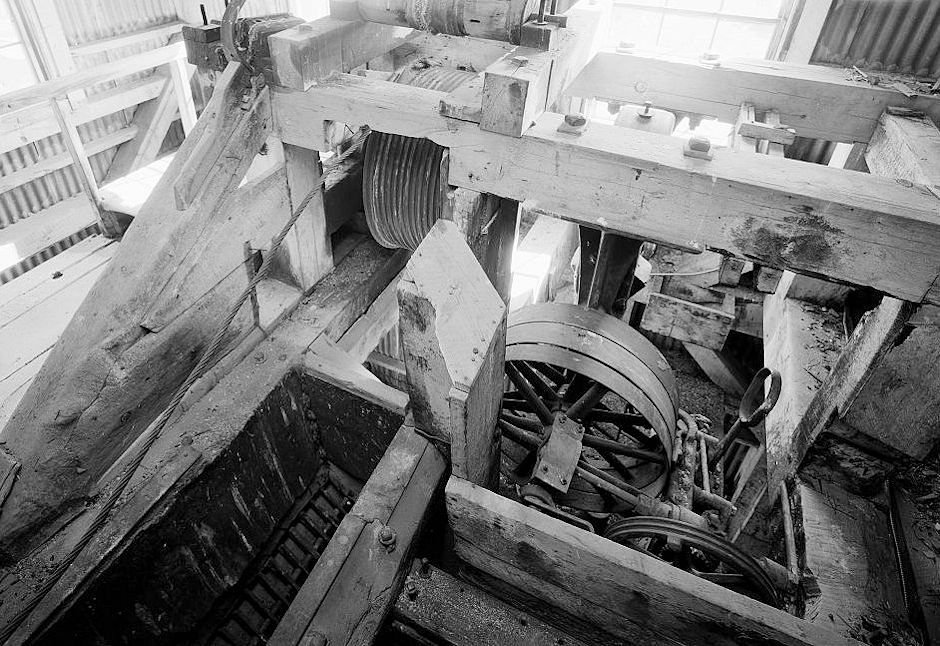
Interior detail from the south end of the delivery (receving level). The detail shows the winding drum and reversing clltch for the tramway ore car, and an ore chute in the floor, foreground bottom left of the image - Photo by Jet Lowe 2000 - Library of congress

Interior view looking sourhwest in the electrical motor room. From left to ritht. DC generator, AC motor, old DC geneator, Opening for the belt to the clutch assembly for the mill power system. The boards that are askew were protection around the drive belt. The small motor in the foreground is the motor that most recently powered the mill's belt drive system - Photo by Jet Lowe 2000 - Library of Congress
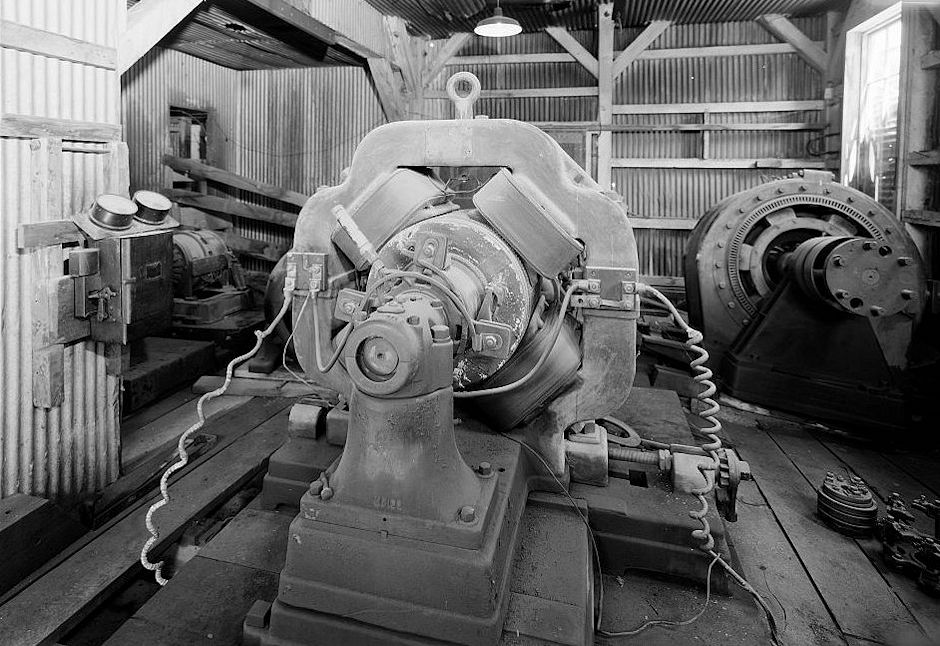
Interior view looking north in the electrical motor room. Close up view of the old DC generator, apparatus on the floor are for the operation of the DC generator. An AC motor is in the background right - Photo by Jet Lowe 2000 - Library of Congress

Interior view looking southwest in the electrical motor room. Control Panels are on the left side of the image (most of the salvabeable equipment has been removed from these panels). A transformer for general electroca; needs in the mill is located above the door - Photo by Jet Lowe - Library of Congress
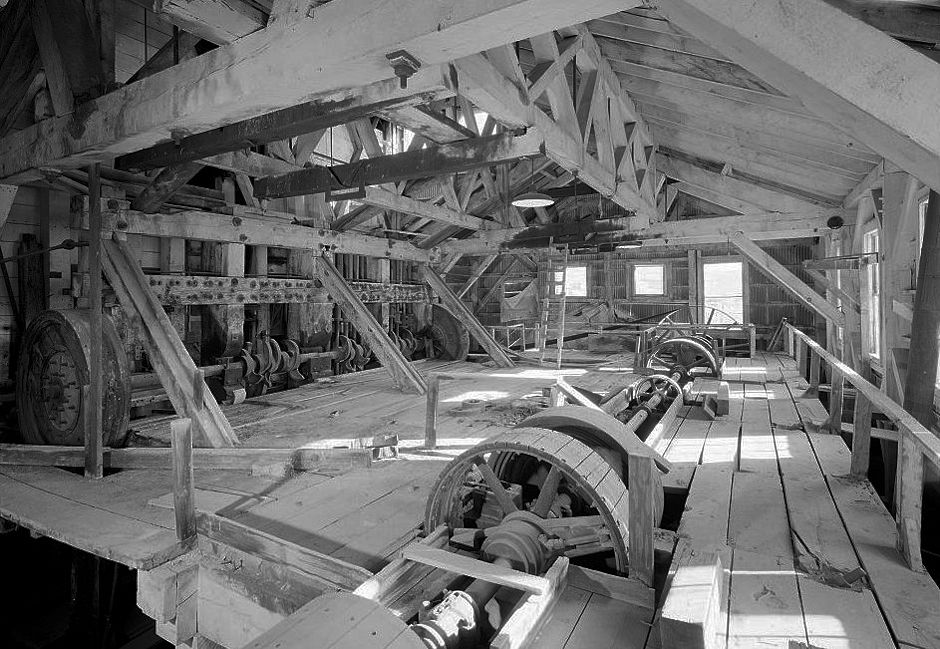
Interior view looking south on the main power shaft/cam level. The stamp batteries are toward the left of the image. Note the camp that are used to lift and release the stamps. The main power shaft is toward the right side of the image. The main drive wheel that is connected to the power source is the large wheel in the extreme background along the shaft - Photo by Jet Lowe - Library of Congress
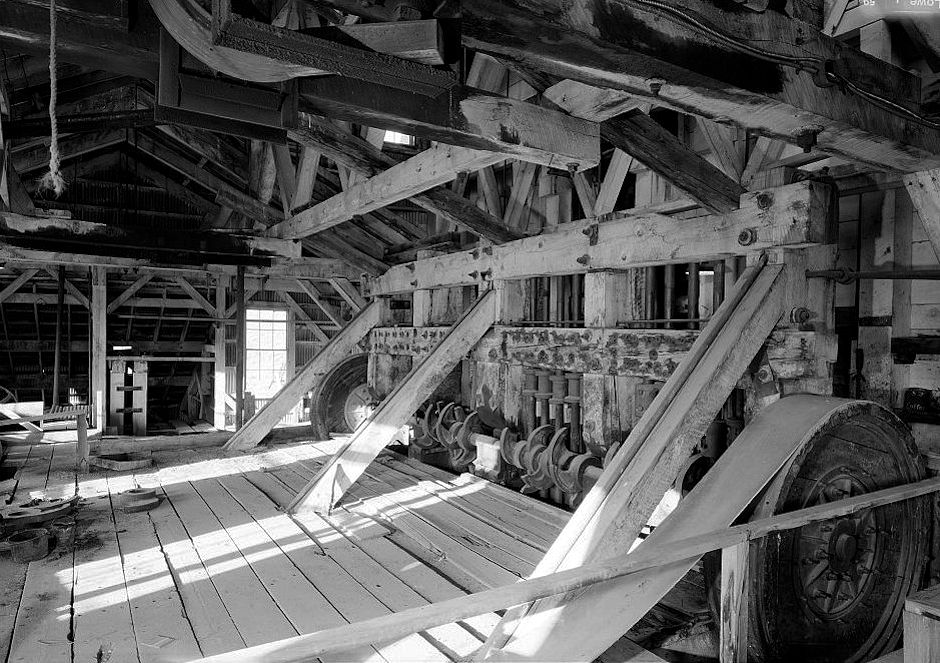
Interior view looking northeast at the stamp batteries. One of the drive wheels is on the foreground right with an extant drive belt. The cam shaft extends to the background center - Photo by Jet Lowe - Library of Congress
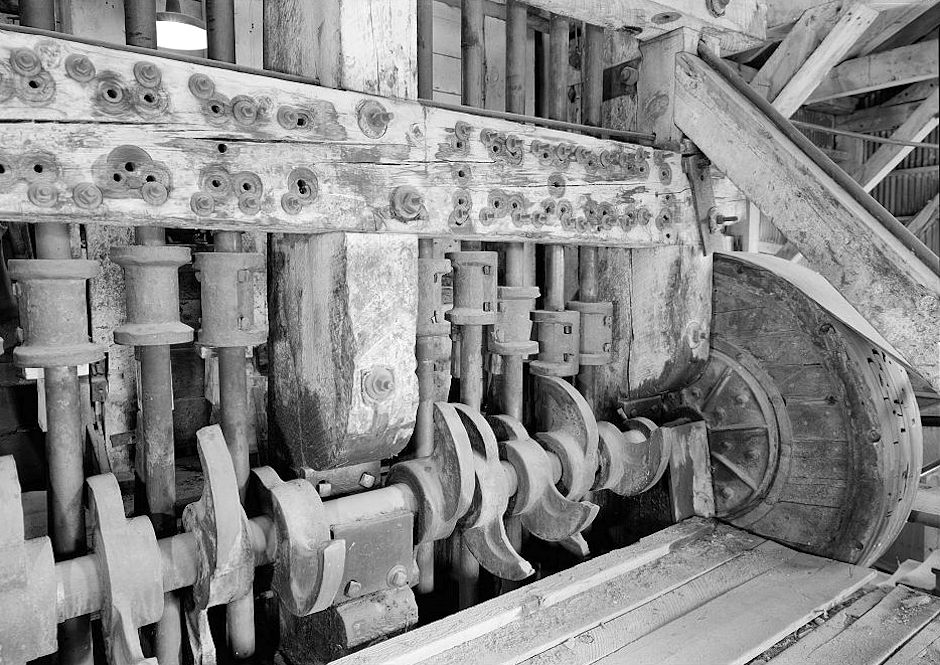
Detail view of the stamp batteries showing the support structure, cams, tappets on the stamp shafts and one of the two drive wheels - Photo by Jet Lowe - Library of Congress
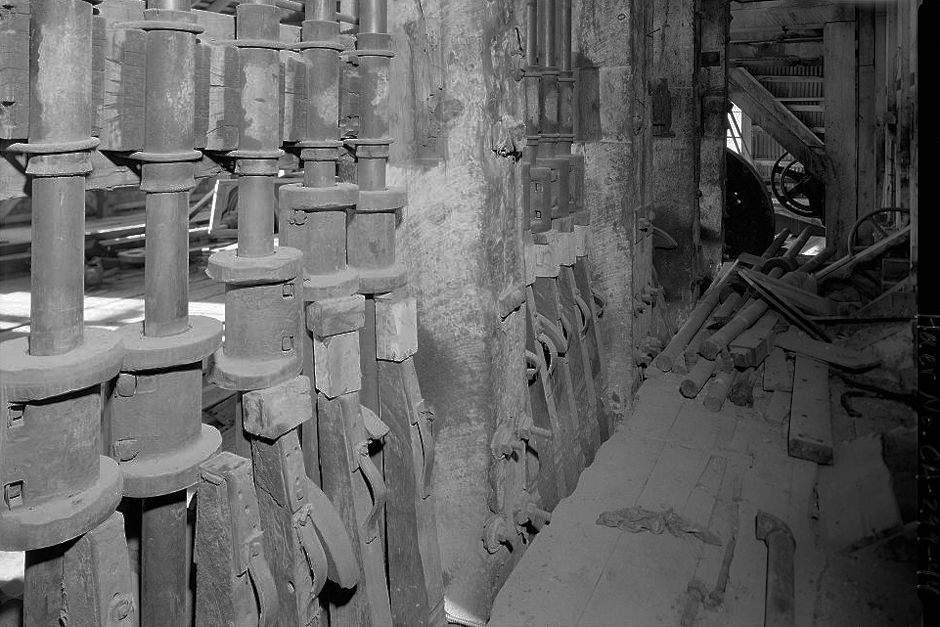
Interior view looking north northwest behind the stamp batteries. This is a close up view of the stamp shafts with the tappets and wooden stops that were used to place the stamps in an up position to clean or replace the stamp shoes in the mortar bax - Photo by Jet Lowe - Library of Congress
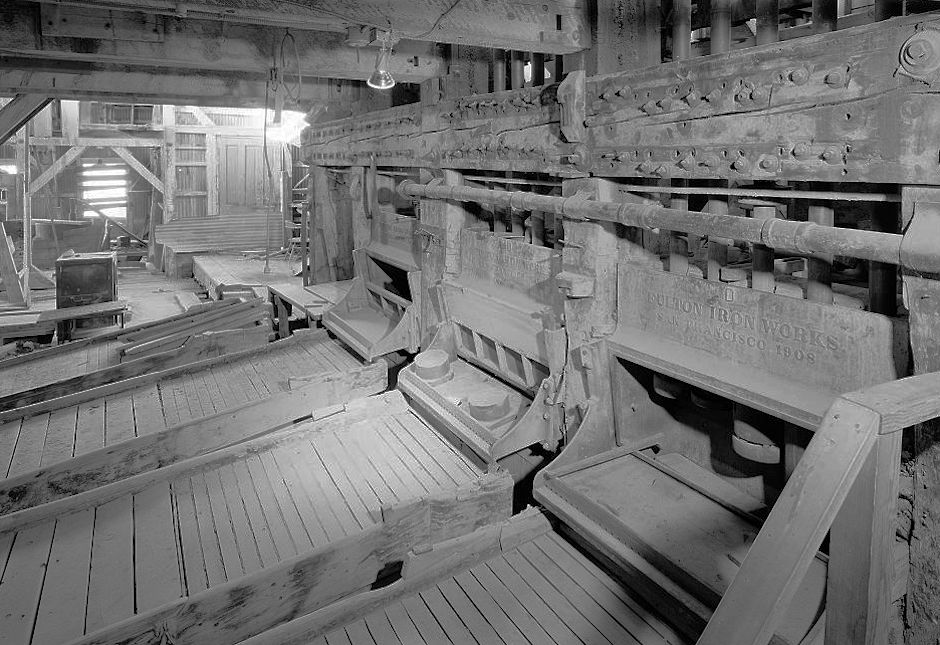
Detail view of the mortar boxes, stamp batteries and amalgamation tables. Note Fulton Iron Works, San Francisco 1908 stamped into the mortar box. Also note the dies resting on the outside of the mortar box by the second stamp battery from the camera position - Photo by Jet Lowe - Library of Congress
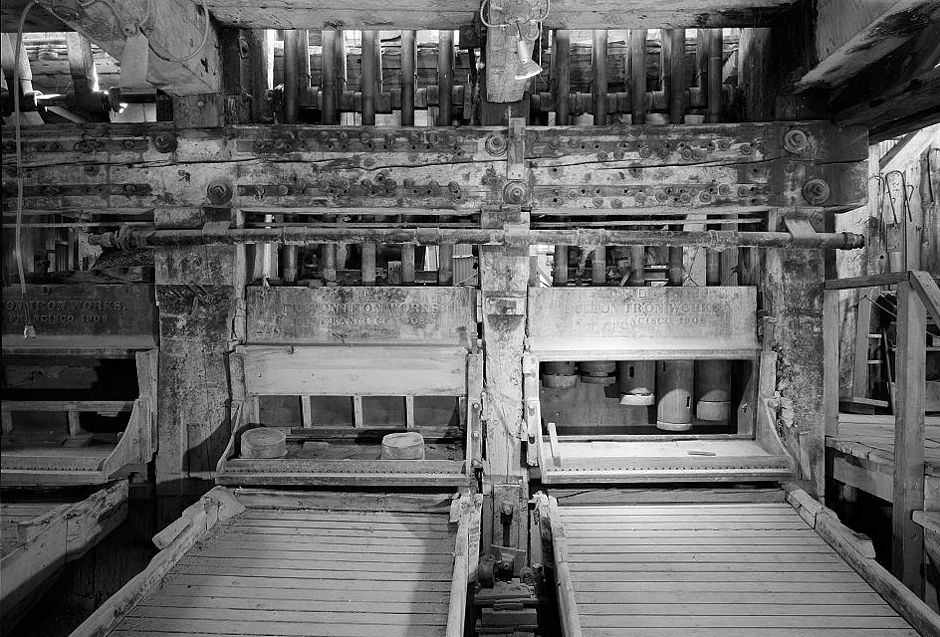
Interior view looking north at the front of the stamp batteries and mortar boxes. The amalgamation tables extend to the foreground and bottom of the image - Photo by Jet Lowe - Library of Congress
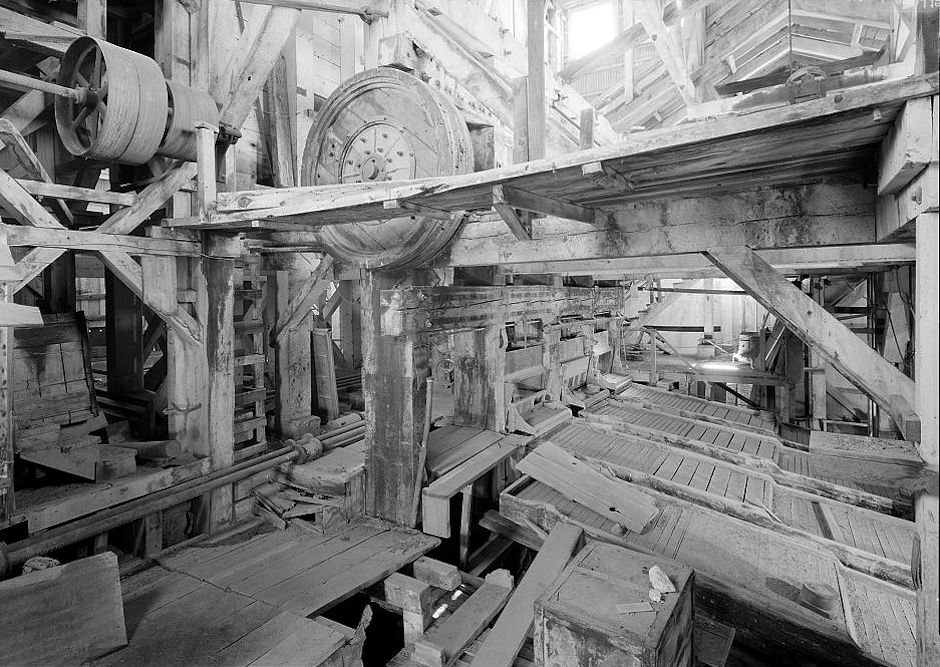
Interior view looking southeast. View shows both the power shaft/cam level and the stamp level. The pulleys in the upper left corner of the image were used to power the #3 Frenier Pump. Directly beneath them. on the stamp level are twp shafts from a disassembled stamp battery. The object in the lower foreground of the image is a safe which is believed to have held the amalgam waiting to be retorted - Photo by Jet Lowe - Library of Congress

Interior view looking north in the Vanner room. Vanner in the foreground is intact but is missing the main belt surface. - Photo by Jet Lowe - Library of Congress
A Vanner is a shaking rubber belt used in stamp mills to concentrate gold ore pulp. The belt moves over a top roller, with the heavier ore sticking to it, and then passes into a water-filled box where the ore is deposited.
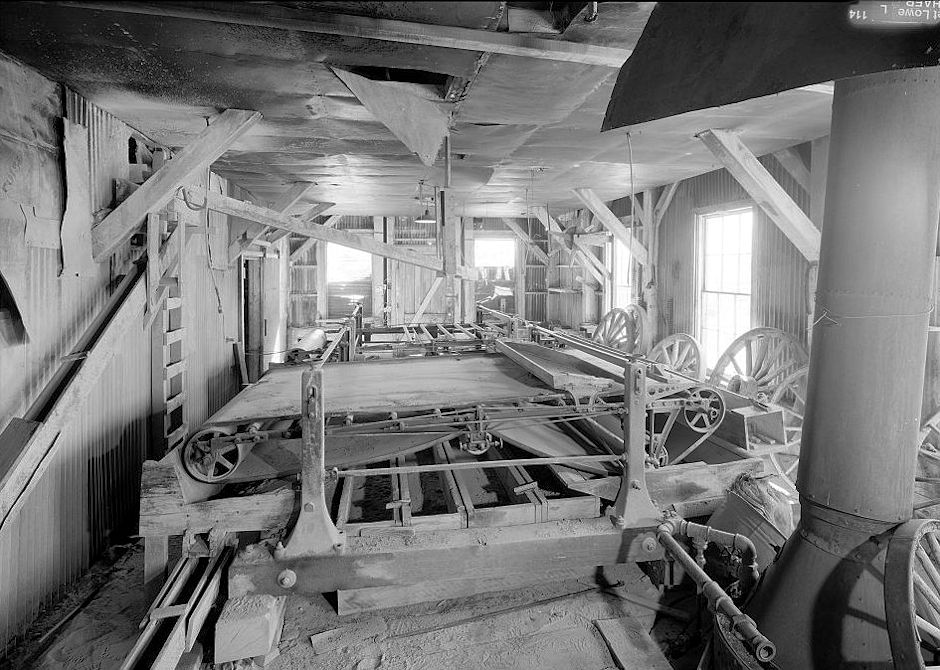
Interior view looking south in the Vanner room. The vanner in the foreground is intact and does have its main belt surface. The stack from a boiler below is in the foreground right. View also shows wooden distribution box on the left side of the image - Photo by Jet Lowe - Library of Congress
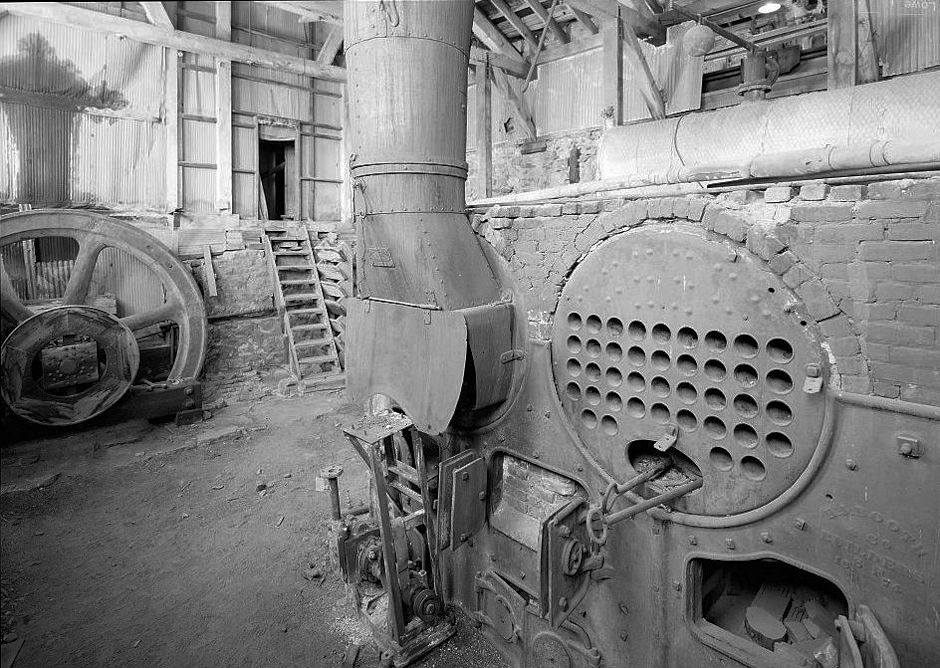
Interior view looking northeast in the boiler room. Note the fly wheel from the original steam engine and a stairway leading onto the stamp battery floor. Makers late at base of stack says; Prescott Scott and Co. Buildirs 1879, Cast into boiler front at lower plant corner it says: H.J. Booth and Co. Builders, SF, 1874 - Photo by Jet Lowe - Library of Congress
